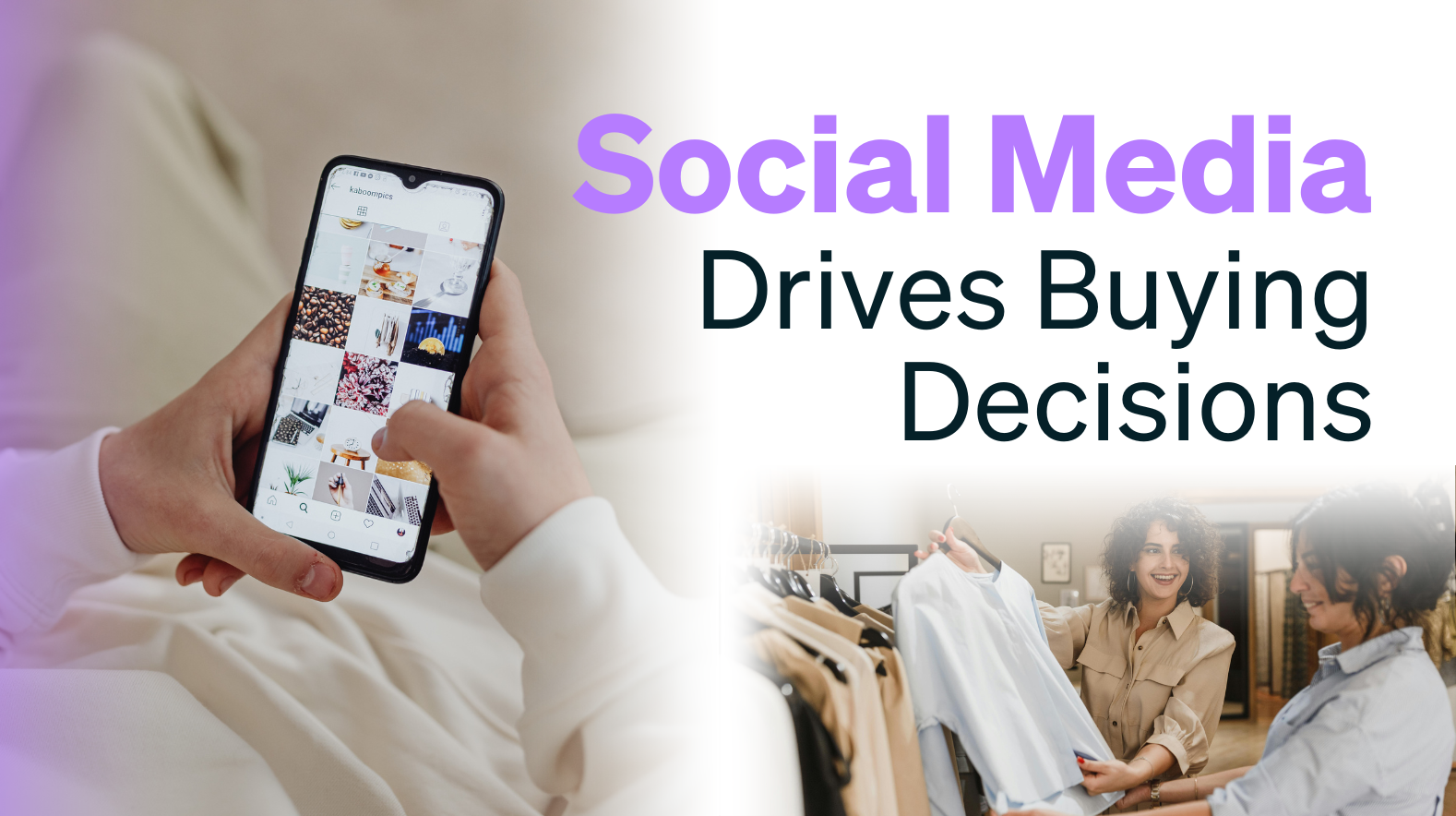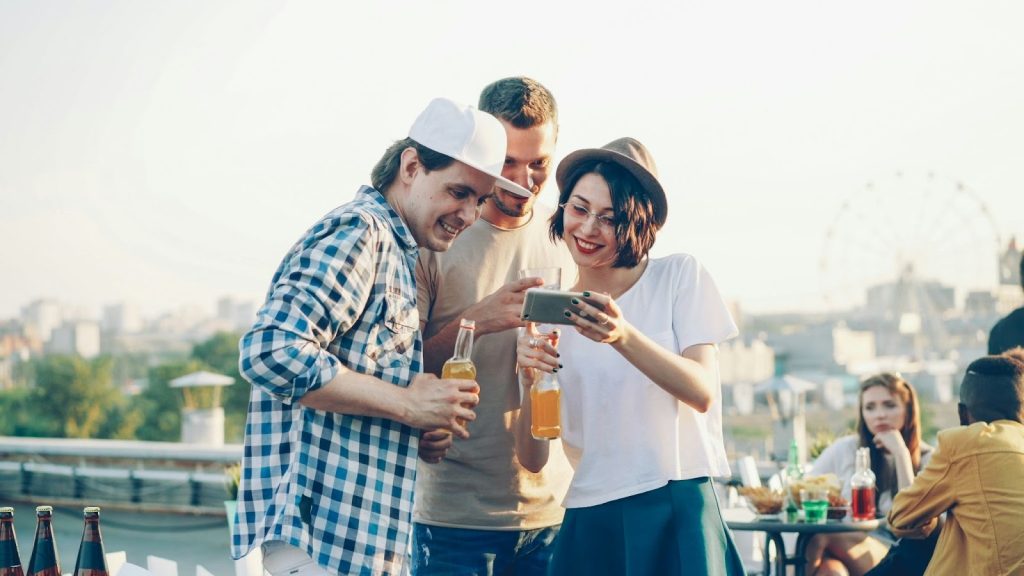
Discover how social media drives buying behavior, from viral trends to influencer-led sales. Learn from brands like Mamaearth, Zomato, and Swiggy how to turn influence into measurable growth.

Have you ever bought something just because you saw it on Instagram or TikTok?
You’re not alone. In today’s digital-first world, social media drives buying decisions more than ever before, transforming how consumers discover, evaluate, and purchase products.
Platforms like Instagram, YouTube, and TikTok are no longer just for entertainment; they’ve become powerful engines of social commerce that shape every stage of the customer journey. According to a 2024 Hootsuite Digital Trends Report, 82% of consumers have purchased a product directly through social media. In addition, DataReportal’s Global Digital Report 2024 notes that the average person spends 2 hours and 24 minutes daily on these platforms clear proof that social media drives buying decisions by constantly influencing perceptions and purchase intent.From viral trends to influencer content, social media drives buying decisions through visual storytelling, emotional connection, and peer recommendations that redefine modern consumer behavior.
1. The Power of Visual Influence
We live in a visually driven world where aesthetics inspire action. A single TikTok video or Instagram Reel can make a product go viral overnight.The hashtag #TikTokMadeMeBuyIt perfectly reflects how social media drives buying decisions and shapes modern online shopping trends. Over 70% of shoppers say they’re more likely to buy a product after seeing it on social media, proof that visual storytelling and emotional marketing are far more persuasive than traditional advertising. When brands understand how social media drives buying decisions, they can create content that resonates emotionally and converts effortlessly.
2. Trust and the Rise of Influencer Marketing
Gone are the days when celebrities alone shaped opinions. Today, influencer marketing and relatable creators lead the way.
Micro-influencers and real customers build genuine trust with audiences through honest reviews, lifestyle reels, and unfiltered posts. Brands that collaborate with influencers strategically see higher engagement and stronger relationships, a clear example of how social media drives buying decisions through authenticity and connection.
Authentic endorsements trigger the psychology of social media marketing, where connection matters more than promotion.
3. The Psychology Behind Social Media Purchases
Social media marketing thrives on emotion, the need for belonging, aspiration, and instant gratification. When people see others enjoying a product, it activates social proof at the very heart of digital consumer behavior.
Every like, share, and comment becomes a micro-moment of influence, gently shaping how social media drives buying decisions across demographics. It’s not manipulation, it’s trust built through relatable stories and consistent engagement that make brands part of everyday life.
4. From Browsing to Buying: The Rise of Social Commerce
Thanks to social commerce, the shopping journey is faster than ever. Social commerce sales are expected to reach $1.2 trillion globally by 2025, with India among the fastest-growing markets (Accenture, 2024).
Features like Instagram Shops, Facebook Marketplace, and TikTok Shop merge content and commerce seamlessly. Consumers can now discover, review, and purchase products in seconds making social media the new digital storefront.
This evolution shows how social media drives buying decisions from curiosity to conversion, turning engagement into measurable sales.
5. Community Trends and Peer Influence
Social media isn’t just about products; it’s about people and shared experiences.
Communities and trends drive collective consumer buying behavior whether it’s a skincare routine, fitness challenge, or trending aesthetic.
People buy to belong. For brands, success lies in joining conversations, encouraging participation, and creating authentic campaigns that reflect social media drives buying decisions in 2025. Being real is no longer optional; it’s the foundation of social media influence that leads to long-term loyalty and consistent sales.
Let’s explore a real-world example of how a brand used social media influence to drive measurable sales.
Case Study — How Mamaearth Turned Social Media Influence into Real Sales

Overview: Mamaearth, a homegrown Indian skincare brand, showcases how social media buying behavior and influencer marketing can transform awareness into measurable sales. In today’s era of social commerce, where social media influences buying decisions, Mamaearth stood out by focusing on authentic storytelling, digital consumer behavior, and community-driven engagement rather than big ad spends.
The Challenge: Building Trust in a Crowded Market
Entering India’s competitive skincare industry, Mamaearth faced the challenge of winning trust among digitally savvy consumers.
Instead of competing through traditional ads, the brand tapped into social media influence and authentic brand storytelling to connect emotionally with audiences.
By aligning its message around being natural, toxin-free, and honest, Mamaearth built credibility through influencer recommendations and user-generated content (UGC) that reflected real experiences and built consumer trust on social media.
The Strategy: Authentic Influencer Engagement
Mamaearth’s influencer marketing strategy focused on micro-influencers, real people, including moms, lifestyle creators, and skincare enthusiasts whose relatable content mirrored everyday life. Instead of scripted promotions, influencers shared genuine stories, which aligned with the psychology of social proof and emotional marketing.
Campaigns like #GoodnessInside and #MamaearthGlow encouraged social media engagement and community-driven marketing, turning followers into loyal customers.
The Results: Authenticity That Converts
The brand’s influencer collaborations led to measurable results, proving the impact of social media on consumer behavior:
(a) 35% increase in online sales within a year
(b) 3x higher engagement than traditional paid ads
(c ) Rapid growth in brand community and online consumer loyalty
These outcomes highlight how authentic influencer marketing directly impacts ROI and strengthens digital brand trust.
The Psychology: Why Authenticity Works
Influencer marketing works because it taps into the psychology of buying behavior and emotion before logic. When audiences see relatable influencers using a product, it builds social proof and triggers emotional trust, a key factor in digital purchase decisions.
This combination of relatability, transparency, and consistent engagement transforms passive scrollers into active buyers proving that authentic content outperforms traditional advertising every time.
Key Takeaway:
Mamaearth’s success story proves that in today’s digital-first market, social media influence drives not just awareness but actual sales. Brands that focus on authentic influencer partnerships, social proof, and community engagement can convert engagement into revenue.
Why Do Brands that Leverage Social Media Influence Sell More?
In the digital-first era, social media has evolved from a branding tool into a powerful sales engine. According to Statista (2024), 78% of consumers say social media drives buying decisions and directly impacts their purchase behavior. Successful brands like Zomato and Swiggy prove that emotional connection and authenticity drive measurable conversions, a clear reflection of how social media drives buying decisions across industries.
1. Emotional Engagement Converts
Brands that communicate with humor, empathy, and relatability like Zomato create emotional bonds that turn casual engagement into loyal purchases. Their content shows how social media drives buying decisions through storytelling that connects to everyday emotions and real-life moments.
2. Authentic Influencers Build Trust
Consumers trust real people over celebrities. Swiggy’s #VoiceofHunger campaign empowered everyday users, earning over 16 million impressions and significantly boosting engagement and orders. This is a prime example of how social media drives buying decisions through authentic voices and community participation.
3. Data-Driven Storytelling
Behind every viral moment lies strategy. Brands blend analytics with creativity to optimize campaigns for higher ROI, balancing emotion and performance.
4. Community is the New Funnel
Modern consumers don’t just buy things, they join movements. Online communities built around shared experiences amplify brand reach and conversion power.
5. Key Takeaway for Brands
To sell more, brands must go beyond posting they must leverage social influence strategically:
(a) Build a relatable, consistent brand voice
(b) Collaborate with authentic creators
(c) Track engagement-to-conversion metrics
(d) Use storytelling to humanize the brand
In short, social media drives buying decisions because it turns trust and emotion into tangible business results one post, share, and community at a time.
Quick Tips: Turn Social Media Influence into Sales
Brand Tip: Partner with 3–5 micro-influencers whose audience matches your target market instead of spending your budget on one macro celebrity. Authenticity scales better than reach.
Marketing Tip: Use platform-native features like Instagram Shops or TikTok Shop. Reduce the number of clicks between “See” and “Buy” conversion rates by 25–30%.
Growth Tip: Join trending challenges early or create your own hashtag to boost discoverability. Encouraging user-generated content drives trust and organic reach.
Content Tip: Focus on visual storytelling short Reels, TikToks, or behind-the-scenes videos that show real product use. Authentic visuals drive 2x higher engagement than polished ads.
Engagement Tip: Reply to comments, DMs, and mentions within 24 hours. Quick, human responses build community trust and can increase repeat purchase intent by up to 40%.
Conclusion for Social Media Drives Buying Decisions

In today’s digital-first era, social media buying behavior defines how modern consumers connect with brands, evaluate options, and make purchasing decisions.What began as a tool for communication has evolved into a powerful force of social media marketing and influence a world where social media drives buying decisions for millions across the globe.
From influencer marketing campaigns to seamless social commerce experiences, brands are no longer just advertising, they’re inspiring trust and action. The impact of social media on consumer behavior is evident: people don’t just see content, they act on it. Whether it’s a viral reel, a heartfelt review, or a trending hashtag, digital consumer behavior now revolves around authenticity and connection, showing again how social media drives buying decisions through emotional engagement and relatability.
The success stories of brands like Mamaearth, Zomato, and Swiggy prove how social media influence on purchasing decisions and visual storytelling drive measurable sales. These brands understand the psychology of social media marketing, using emotion and relatability to turn engagement into conversions. It’s no longer about promotion; it’s about creating experiences that align with evolving social media and shopping habits and spark emotional marketing moments that last.
As online shopping trends continue to grow, the power of social media marketing will only deepen. Every post, like, and comment plays a role in shaping digital influence on purchase decisions, proving that social media drives buying decisions and that its impact on sales is real and measurable. By 2025, over 76% of online shoppers are expected to rely on social media recommendations before making a purchase (Statista, 2025). The message is clear social media doesn’t just drive awareness, it drives action
At Leo9 Studio, we help brands decode the science behind social media buying behavior, leverage influencer marketing, and master the art of visual storytelling. Our approach blends creativity, psychology, and data to turn social media influence into tangible business growth. Because in the age of social commerce, real influence isn’t bought ,it’s built.
Connect with Leo9 to build a social media strategy that drives buying decisions .
FAQ’s for Social Media Drives Buying Decisions
1. What is social media buying behavior?
Social media buying behavior refers to how consumers discover, evaluate, and purchase products based on what they see on platforms like Instagram, YouTube, and TikTok.
From viral trends to influencer recommendations, every like or share influences perception and purchase intent. At Leo9 Design, we help brands decode this behavior transforming casual engagement into intentional conversions through data-backed storytelling and emotional branding.
2. How does social media influence consumer buying behavior?
Social media influence shapes how people trust and choose brands. Visual content, influencer marketing, and authentic storytelling create emotional triggers that guide decisions.
Our team at Leo9 Design uses behavioral insights and content strategy to help brands not just attract followers but convert them into loyal customers.
3. What is social commerce?
Social commerce means buying and selling directly through social media platforms like Instagram Shops or TikTok Shop where content meets commerce.
At Leo9, we design seamless shopping experiences that reduce friction between “See” and “Buy,” ensuring every interaction leads closer to conversion.
4. How does influencer marketing affect buying behavior?
Influencer marketing drives social proof when consumers see real people using a product, trust builds naturally.
We at Leo9 Design craft influencer collaboration strategies that focus on authenticity over reach, turning micro-influencers into brand advocates who inspire genuine buying behavior.
5. What is digital consumer behavior?
Digital consumer behavior studies how people act online, how they search, compare, and decide what to buy.
Using insights from digital psychology and analytics, Leo9 Design helps brands understand what motivates their audience and designs content journeys that align perfectly with that decision-making process.
6. How do online shopping trends change because of social media?
Social media evolves faster than any other platform, and so do shopping trends. Viral videos, hashtags, and influencer-led campaigns redefine what’s popular sometimes overnight.
Leo9 Design stays ahead of these shifts, creating adaptive strategies that help brands capitalize on trends without losing authenticity or consistency.
7. Why is visual storytelling important in social media marketing?
Because people don’t buy products they buy stories.
Visual storytelling builds emotional connections that make brands memorable and trustworthy.
At Leo9 Design, our creative team blends design, motion, and message to craft social media stories that not only capture attention but inspire action.
8. How does emotional marketing improve social media influence?
Emotional marketing connects with the heart before the mind.
When people feel understood by a brand, they engage deeper and buy with confidence. At Leo9, we specialize in designing emotionally intelligent campaigns that humanize brands turning likes into loyalty and influence into measurable growth.





